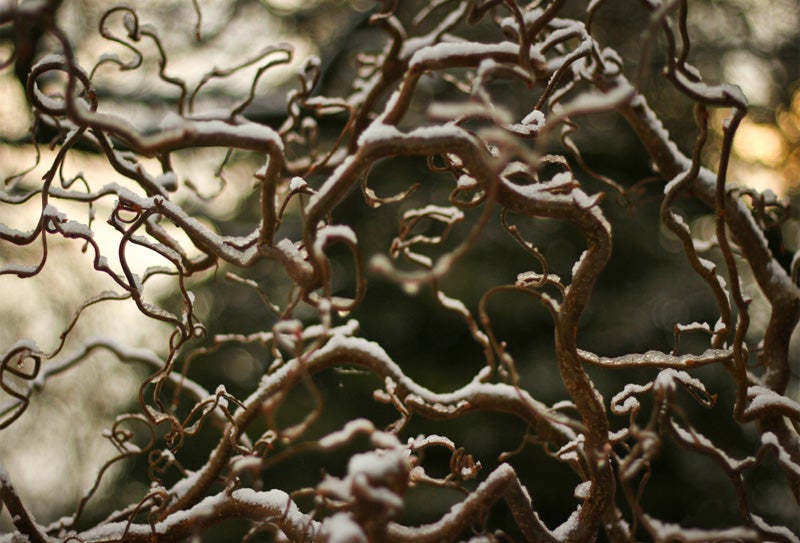You won’t believe what you CAN put in your compost pile
ListenMike McGrath explains how to treat an infested Harry Lauder’s Walking Stick bush, what to do to prevent a major slug problem, the basic timeline for lawn care, how to plant a Japanese maple, tips for tending to a community garden and surprising things you CAN include in your compost pile. Plus, Mike speaks with Sylvia Bernstein about aquaponic gardening.
Questions of the Week:
“My compost pile is squidgy, has big chunks of stuff in it, and doesn’t resemble dirt as much as I would like. I’ve got coffee grounds, kitchen waste and leaves in there (un-shredded leaves, as I’m lazy). It does get turned when the weather is nice… “
— Jess in La Vergne, Tennessee
“I listen to your Podcast and love it. Recently my neighbors, who have an urban farm with goats, ducks, and chickens, gave me some of their composting piles of manure and straw bedding. But the compost is wet and clumpy; very different from both my worm castings and the compost I’ve purchased. Should I plop the mud-like clumps of compost around my plants? Or try and dry it out first?”
— Fon in Portland, Oregon
“I have some yeast that has passed its expiration date. I don’t want to risk making bread with it and was wondering if it should go into the compost bin.”
— BJ from Oriental, North Carolina
“I just watched Mike’s TEDx talk on composting on YouTube and learned so much. But I am hungry for knowledge on this subject and have a few ‘follow up’ questions. #1) How much sunlight should a black plastic compost tumbler get each day? #2) How ‘much’ coffee grounds should I use in relation to leaves? #3) Should I continue to add more grounds and leaves as the pile reduces in size, or let one batch finish completely and then start another? #4) Can I use grass clippings and brown leaves from plants that aren’t trees?”
— Josh in Northern Florida
” Loved your TEDx talk! Do you have any thoughts on using human urine in a compost pile or directly on plants?”
— Jordan in San Francisco
Surprising things you CAN put in your compost pile »
Highlights from show for April 19, 2014:
An infested Harry Lauder’s Walking Stick bush
Last summer Joe from Center City, Philadelphia noticed that his Harry Lauder’s Walking Stick bush was infested with a tent insect. He calls Mike for advice on preventing these pests. From Joe’s description, Mike thinks that these unidentified insects can be easily defeated with safe treatments. Mike explains: “Insecticidal soaps and horticultural oils can be very effective treatments but they must be sprayed on the insect to be effective. They have no residual action. So if you’re spraying insecticidal soap on a leaf and you can’t see any bugs all you’re doing is putting soap on the leaf.” Mike suggests that Joe spray down the bush every week with a sharp stream of water to remove any insects hoping to take up residence.
Preventing a major slug problem
Slugs were a huge problem for Bernadette from Bucks County, Pennsylvania last year. The slugs from her garden infested the drain pipe from her air conditioning unit and caused major damage to her home. She calls Mike looking for a chemical-free preventative strategy to control these pests. Mike heard about a similar case where a garter snake got into a drain pipe and wreaked havoc! He advises Bernadette to take some simple steps to secure her pipe: “So you want to do two separate things: first you want to get what’s called hardware cloth, like a fine mesh screening, and put that over the bottom of the pipe so that the hole is not open. And then, to keep slugs away, you want to get some copper flashing, the stuff they use on the roof to separate out the chimney from the shingles, and wrap the pipe with copper flashing. Because I’m afraid that even if you make the pipe slug-proof something else can get into that opening.” This should prevent slugs, snakes, toads, mice, and other critters from tampering with Bernadette’s cooling system.
Lawn care timeline
Carmella from Westchester, Pennsylvania put down grass seed during the ideal late-summer window. She calls to ask Mike if, and when, she should spread corn gluten meal this spring to prevent crabgrass. “One of the issues is the timing of course. Crap grass germinates at a soil temperature of 55 degrees, which is generally when forsythia blooms. So if you live in an area where the forsythia has not yet fully bloomed or you can stick a soil thermometer down and it’s not yet or hasn’t been at 55 for a couple days, by all means yes!” Luckily, Carmella’s forsythia hasn’t bloomed and she still has time to treat her lawn. Regardless, Mike reminds her that even if she had missed the window when corn gluten is most effective, it might still have been worth treating her lawn with some to help strengthen the grass.
“One of the issues [with spring lawn treatment] is the timing of course. Crap grass germinates at a soil temperature of 55 degrees, which is generally when forsythia blooms. So if you live in an area where the forsythia has not yet fully bloomed or you can stick a soil thermometer down and it’s not yet or hasn’t been at 55 for a couple days, by all means yes!”
Mike McGrath
-

Photo by Flickr user Víctor Nuño
Special guest: Sylvia Bernstein
Mike spoke with author Sylvia Bernstein, about growing in an aquaponics system. Bernstein is the author of Aquaponics Gardening: A Step-by-Step Guide to Raising Vegetables and Fish Together. In this conversation Bernstein goes through all the components needed to create your own aquaponics system which could be as small and simple as growing a few lettuces to growing sweet corn! The best part? You can get the necessary bacteria for the system from slime found on rocks in your average pond or stream. How fun is that!
Planting a Japanese maple
Richard from Surgoinsville, Tennessee loves Japanese maples and wants to plant one in his yard. He calls Mike for advice on purchasing and planting. Mike explains some tree-planting basics: “First with any tree is to buy a nice, healthy-looking specimen. So go to a good independent garden center … pick out a nice tree … depending on the size of the tree you’re buying … see if they’ll deliver it for you!” Choosing a spot that does not get too much shade or too much sun is also essential. For planting, the first step is to remove all wrappings: burlap, wire cages, plastic strings, or anything else. Mike reminds Richard that many people make the mistake of planting trees too deeply. “The planting hole should not be overly deep, but it should be as wide as you can make it … When you put the tree into the planting hole for the first time to see if it’s the right depth? I want the root flare to be above ground.. you want to see the top of the root structure always above the ground.” Finally, Mike advises Richard put a ring of compost mulch 6-8 inches away from the trunk to slowly improve the soil and encourage root growth, rather than enriching the planting hole only which can weaken a tree.
Weeds in a community garden
Anne from Media, Pennsylvania lives in a Senior Living Community that has recently started a community garden. She calls Mike with some questions about weed management. After Mike explains to Anne that her neighbor’s homemade weed-killer is unsafe and not organic, he determines that the weed problems are mostly being caused by the tilling they’ve done each year. Mike explains: “We can’t tell people this enough at this time of year: When you till, you expose all these dormant weed seeds to the trigger for germination, which is sunlight, and then you cover them over again and you feed and water them. And those weeds would not have been there if you hadn’t tilled.” Mike recommends installing raised beds to keep out the weeds so Anne and her fellow seniors can spend more time growing and less time weeding. In the meantime, Mike suggests frequent weed-whacking around the boarder of the garden instead of annual tilling.
— This week’s post was written by Marissa Nicosia, You Bet Your Garden intern
WHYY is your source for fact-based, in-depth journalism and information. As a nonprofit organization, we rely on financial support from readers like you. Please give today.





